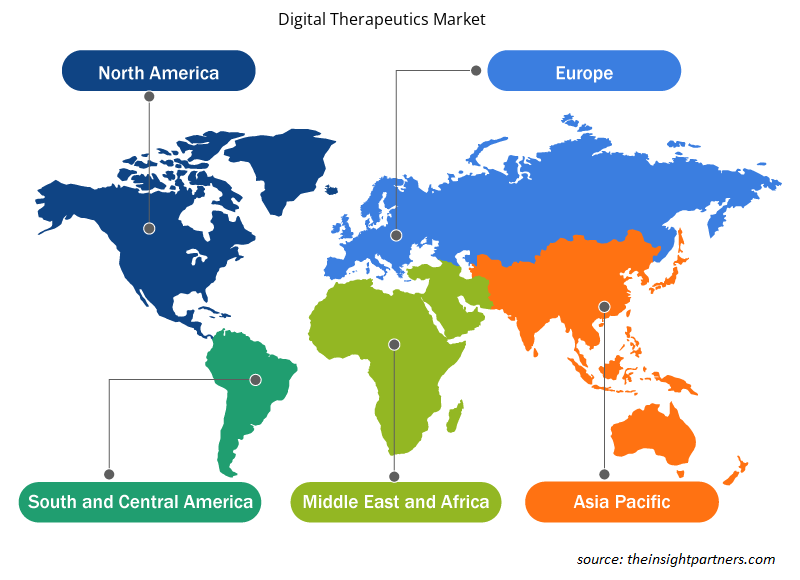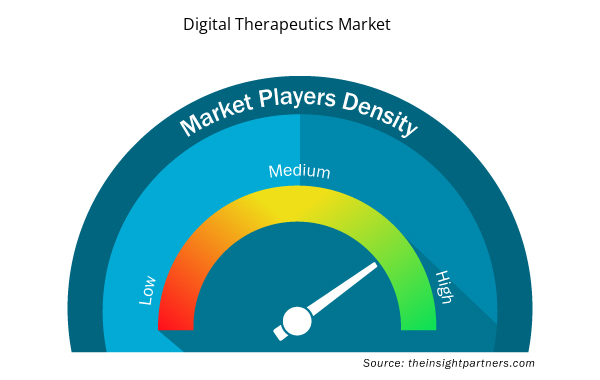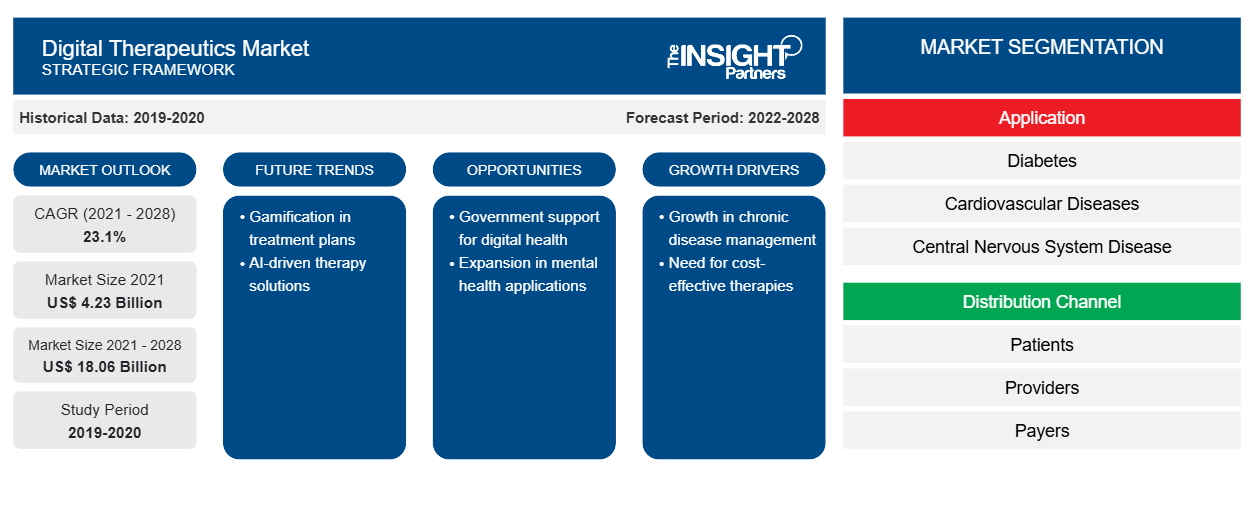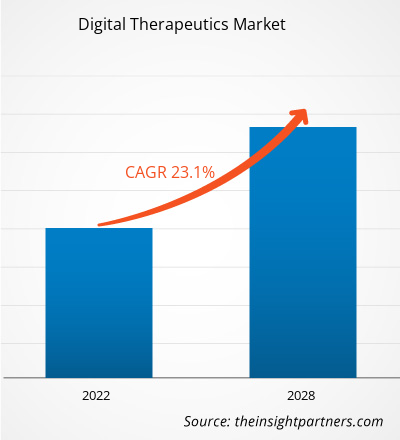[研究报告] 2021年数字治疗市场规模价值为 42.2694 亿美元,预计到 2028 年将达到 180.6179 亿美元;预计 2022 年至 2028 年的复合年增长率为 23.1%。
分析师观点
市场可能会受到以下因素的推动:发达国家和新兴国家智能手机普及率的提高、数字医疗技术对供应商和患者的成本效益,以及对综合医疗系统和以患者为中心的治疗的需求不断增长。据 Kepios 称,到 2021 年 4 月,全球互联网用户将达到 42.7 亿,占全球人口的 60% 以上。随着这一数字的增加,人们对智能健康追踪的认识有望提高。发达经济体的消费者越来越了解用于治疗疾病的创新医疗产品。根据经济合作与发展组织的数据,由于几个经合组织国家的经济状况恶化,医疗支出增加,2020 年医疗保健支出占 GDP 的比例大幅上升。因此,人们的偏好转向了先进的医疗服务,包括对先进治疗设备的需求增加。产品接受度是推动市场扩张的另一个方面。
市场概况
数字疗法为患者提供循证治疗干预,重点是通过程序治疗疾病,并使用高质量软件进行管理。数字疗法在过去几年中取得了进展,利用技术补充或可能取代传统的临床治疗。它们可以单独使用,也可以与设备、药物或其他疗法配合使用,以优化患者护理和健康结果。促进数字疗法市场增长的关键因素是慢性病患病率的上升、对降低医疗成本需求的担忧以及公司的伙伴关系和合作。然而,网络威胁和数据安全性的提高阻碍了市场的增长,这限制了其在医疗领域的潜在应用。
定制此报告以满足您的需求
您可以免费定制任何报告,包括本报告的部分内容、国家级分析、Excel 数据包,以及为初创企业和大学提供优惠和折扣
- 获取此报告的关键市场趋势。这个免费样品将包括数据分析,从市场趋势到估计和预测。
市场驱动因素
慢性病患病率上升推动数字治疗市场增长
慢性病,包括心脏病、中风、糖尿病和肥胖症,占所有国家医疗费用的大部分。根据世界卫生组织 (WHO) 的报告,2020 年全球有 4.63 亿成年人患有糖尿病,预计到 2045 年这一数字将上升到 6.29 亿。亚太地区、欧洲以及中东和非洲的糖尿病患病率很高。这种疾病的主要特征是由于人体无法产生或有效利用胰岛素激素导致血糖水平调节不足,并且没有专门的治疗方法。根据国际糖尿病联合会发布的《IDF 糖尿病图谱 2021》,报告称到 2021 年北美约有 5100 万人患有糖尿病,到 2045 年这一数字预计将达到 6300 万人。此外,东南亚的糖尿病患者人数约占全球的 16.8%。到 2035 年,预计美国约有 1.3 亿成年人将患有某种形式的心血管疾病。
由于久坐不动和不健康的生活方式,全球发达经济体和发展中经济体的肥胖率正在迅速上升。根据经济合作组织 (OECD) 2017 年发布的数据,OECD 地区约有 19.5% 的成年人口肥胖。韩国和日本的肥胖率不到 6%,匈牙利、新西兰、墨西哥和美国则超过 30%。此外,在过去十年中,澳大利亚、加拿大、智利、南非和英国的肥胖率迅速上升,约有 25% 或更多的成年人肥胖。到 2030 年,美国、墨西哥和英国的肥胖率预计将分别达到约 47%、约 39% 和约 35%。
为了加强慢性病管理并为患者提供更多治疗选择,数字疗法有助于提供基于证据的治疗解决方案。它使患者能够更好地控制自己的护理,并为糖尿病等慢性病管理提供潜在的解决方案。因此,慢性病患病率的上升正在推动数字疗法市场的发展。
节段分析
基于应用的洞察
根据应用,数字治疗市场细分为呼吸系统疾病、中枢神经系统疾病、戒烟、肌肉骨骼疾病、心血管疾病、糖尿病和其他应用。2021 年,糖尿病领域占据了最大的数字治疗市场份额,预计同一领域在预测期内将在市场上实现最高的复合年增长率,原因是全球糖尿病发病率不断上升、发展中国家肥胖症患病率高,以及肥胖相关疾病带来的巨大风险和经济成本。
糖尿病是一种危及生命的慢性疾病,目前尚无专门的治疗方法。它主要是由于人体无法产生或有效利用胰岛素引起的。这种无能使人体无法充分调节血糖水平。糖尿病有两种类型,即 I 型糖尿病(也称为尿崩症)和 II 型糖尿病(也称为糖尿病)。全球糖尿病的发病率和患病率正在稳步上升。2 型糖尿病是最常见的糖尿病形式,随着文化和社会的变化而增加。在高收入国家,多达 91% 的成人患有 2 型糖尿病。根据国际糖尿病联合会 (IDF) 2021 年地图集,全球约有 5.37 亿人患有糖尿病,预计到 2030 年将达到 6.43 亿。
基于分销渠道的洞察
就分销渠道而言,数字治疗市场分为患者、提供者、付款人和雇主。患者部分在 2021 年占据了最大的数字治疗市场份额。然而,提供者部分预计在预测期内将实现最高的复合年增长率。
数字治疗市场区域洞察
Insight Partners 的分析师已详细解释了预测期内影响数字治疗市场的区域趋势和因素。本节还讨论了北美、欧洲、亚太地区、中东和非洲以及南美和中美洲的数字治疗市场细分和地理位置。

- 获取数字治疗市场的区域特定数据
数字治疗市场报告范围
| 报告属性 | 细节 |
|---|---|
| 2021 年市场规模 | 42.3亿美元 |
| 2028 年市场规模 | 180.6亿美元 |
| 全球复合年增长率(2021 - 2028) | 23.1% |
| 史料 | 2019-2020 |
| 预测期 | 2022-2028 |
| 涵盖的领域 | 按应用
|
| 覆盖地区和国家 | 北美
|
| 市场领导者和主要公司简介 |
|
数字治疗市场参与者密度:了解其对业务动态的影响
数字治疗市场正在快速增长,这得益于终端用户需求的不断增长,而这些需求又源于消费者偏好的不断变化、技术进步以及对产品优势的认识不断提高等因素。随着需求的增加,企业正在扩大其产品范围,进行创新以满足消费者的需求,并利用新兴趋势,从而进一步推动市场增长。
市场参与者密度是指在特定市场或行业内运营的企业或公司的分布情况。它表明在给定市场空间中,相对于其规模或总市场价值,有多少竞争对手(市场参与者)存在。
在数字治疗市场运营的主要公司有:
- 螺旋桨健康
- 金丝雀健康
- NOOM 公司
- 2MORROW, INC.
- Teladoc 健康
免责声明:上面列出的公司没有按照任何特定顺序排列。

- 获取数字治疗市场顶级关键参与者概览
区域分析
2021 年,北美占据了数字治疗市场的最大市场份额,预计在预测期内仍将保持其市场地位。推动北美市场增长的因素包括降低医疗成本的需求不断增加、医疗法规越来越严格、医疗行业竞争日益激烈以及技术创新日新月异。此外,大型医疗企业的存在和数字治疗的日益普及正在推动该地区市场的扩张。在北美,美国占据了最大的数字治疗市场份额。数字医疗在美国蓬勃发展,人口老龄化、慢性病患病率上升、监管变化和向基于价值的医疗转变等一系列因素正在支持数字医疗在日常生活中的日益普及。
Propeller Health、Canary Health Inc.、NOOM INC.、2Morrow Inc、Teladoc Health、Welldoc Inc、FITBIT Inc、OMADA Health、Mango Health、Pear Therapeutics Inc 和 Happify Health 是全球数字治疗市场增长的主要参与者。报告还分析了其他几家重要的市场参与者,以全面了解市场及其生态系统。该报告提供了详细的市场洞察,帮助关键参与者制定市场增长战略。以下提到了一些发展:
- 2021年11月,Pear Therapeutics, Inc.宣布其用于治疗酒精使用障碍 (AUD) 的 reSET-A PDT 候选产品已获得美国食品药品监督管理局 (FDA) 颁发的突破性设备称号。reSET-A 有可能扩大 Pear 的成瘾特许经营权,包括 FDA 授权的治疗物质使用障碍 (SUD) 和阿片类药物使用障碍 (OUD) 的产品。
- 2020 年 9 月,Welldoc 宣布其屡获殊荣的糖尿病平台 BlueStar 获得了美国食品药品监督管理局 (FDA) 的第九个 510(k) 批准。新批准将胰岛素剂量支持扩展到大多数类型的胰岛素,包括针对 2 型糖尿病的 Bolus 和预混胰岛素滴定。
- 2021 年 5 月,Teladoc Health, Inc. 宣布推出 myStrength Complete,这是一项综合心理健康服务,通过单一、全面的体验为消费者提供个性化、有针对性的护理。
- 历史分析(2 年)、基准年、预测(7 年)及复合年增长率
- PEST 和 SWOT 分析
- 市场规模价值/数量 - 全球、区域、国家
- 行业和竞争格局
- Excel 数据集


- Virtual Event Software Market
- Workwear Market
- Excimer & Femtosecond Ophthalmic Lasers Market
- Aesthetic Medical Devices Market
- Fish Protein Hydrolysate Market
- Pressure Vessel Composite Materials Market
- Human Microbiome Market
- Single Pair Ethernet Market
- Virtual Production Market
- Malaria Treatment Market

Report Coverage
Revenue forecast, Company Analysis, Industry landscape, Growth factors, and Trends

Segment Covered
This text is related
to segments covered.

Regional Scope
North America, Europe, Asia Pacific, Middle East & Africa, South & Central America

Country Scope
This text is related
to country scope.
常见问题
The global digital therapeutics market, based on application, is segmented into diabetes, cardiovascular diseases, central nervous system (CNS) disease, respiratory diseases, smoking cessation, musculoskeletal diseases, and others. The diabetes segment held the largest share of the market in 2021 and the same segment registered the highest CAGR during the forecast period.
Factors such as the rising prevalence of chronic diseases and the growing need to reduce healthcare costs are driving the digital therapeutics market. However, cyber threats and risks related to data security are hampering the market growth.
Digital therapeutics provide evidence-based therapeutic intrusions to patients that focus on the treatment of diseases with the programs by using the high-quality software. Digital therapeutics have made progress in the last few years, harnessing technology for the supplement or potentially replacing traditional clinical therapy. They are used independently or with devices and medications for the optimization of patient care and health outcomes.
The digital therapeutics market majorly consists of the players such as Propeller Health; Canary Health, Inc.; NOOM, INC.; 2Morrow, Inc.; Teladoc Health; Welldoc, Inc.; FITBIT, Inc.; OMADA Health; Mango Health; Pear Therapeutics, Inc.; and Happify Health.
Trends and growth analysis reports related to Technology, Media and Telecommunications : READ MORE..
The List of Companies - Digital Therapeutics Market
- Propeller Health
- Canary Health
- NOOM, INC.
- 2MORROW, INC.
- Teladoc Health
- Welldoc, Inc.
- FITBIT, INC.
- OMADA Health
- Mango Health
- Pear Therapeutics, Inc.
- HAPPIFY Health.
The Insight Partners performs research in 4 major stages: Data Collection & Secondary Research, Primary Research, Data Analysis and Data Triangulation & Final Review.
- Data Collection and Secondary Research:
As a market research and consulting firm operating from a decade, we have published and advised several client across the globe. First step for any study will start with an assessment of currently available data and insights from existing reports. Further, historical and current market information is collected from Investor Presentations, Annual Reports, SEC Filings, etc., and other information related to company’s performance and market positioning are gathered from Paid Databases (Factiva, Hoovers, and Reuters) and various other publications available in public domain.
Several associations trade associates, technical forums, institutes, societies and organization are accessed to gain technical as well as market related insights through their publications such as research papers, blogs and press releases related to the studies are referred to get cues about the market. Further, white papers, journals, magazines, and other news articles published in last 3 years are scrutinized and analyzed to understand the current market trends.
- Primary Research:
The primarily interview analysis comprise of data obtained from industry participants interview and answers to survey questions gathered by in-house primary team.
For primary research, interviews are conducted with industry experts/CEOs/Marketing Managers/VPs/Subject Matter Experts from both demand and supply side to get a 360-degree view of the market. The primary team conducts several interviews based on the complexity of the markets to understand the various market trends and dynamics which makes research more credible and precise.
A typical research interview fulfils the following functions:
- Provides first-hand information on the market size, market trends, growth trends, competitive landscape, and outlook
- Validates and strengthens in-house secondary research findings
- Develops the analysis team’s expertise and market understanding
Primary research involves email interactions and telephone interviews for each market, category, segment, and sub-segment across geographies. The participants who typically take part in such a process include, but are not limited to:
- Industry participants: VPs, business development managers, market intelligence managers and national sales managers
- Outside experts: Valuation experts, research analysts and key opinion leaders specializing in the electronics and semiconductor industry.
Below is the breakup of our primary respondents by company, designation, and region:

Once we receive the confirmation from primary research sources or primary respondents, we finalize the base year market estimation and forecast the data as per the macroeconomic and microeconomic factors assessed during data collection.
- Data Analysis:
Once data is validated through both secondary as well as primary respondents, we finalize the market estimations by hypothesis formulation and factor analysis at regional and country level.
- Macro-Economic Factor Analysis:
We analyse macroeconomic indicators such the gross domestic product (GDP), increase in the demand for goods and services across industries, technological advancement, regional economic growth, governmental policies, the influence of COVID-19, PEST analysis, and other aspects. This analysis aids in setting benchmarks for various nations/regions and approximating market splits. Additionally, the general trend of the aforementioned components aid in determining the market's development possibilities.
- Country Level Data:
Various factors that are especially aligned to the country are taken into account to determine the market size for a certain area and country, including the presence of vendors, such as headquarters and offices, the country's GDP, demand patterns, and industry growth. To comprehend the market dynamics for the nation, a number of growth variables, inhibitors, application areas, and current market trends are researched. The aforementioned elements aid in determining the country's overall market's growth potential.
- Company Profile:
The “Table of Contents” is formulated by listing and analyzing more than 25 - 30 companies operating in the market ecosystem across geographies. However, we profile only 10 companies as a standard practice in our syndicate reports. These 10 companies comprise leading, emerging, and regional players. Nonetheless, our analysis is not restricted to the 10 listed companies, we also analyze other companies present in the market to develop a holistic view and understand the prevailing trends. The “Company Profiles” section in the report covers key facts, business description, products & services, financial information, SWOT analysis, and key developments. The financial information presented is extracted from the annual reports and official documents of the publicly listed companies. Upon collecting the information for the sections of respective companies, we verify them via various primary sources and then compile the data in respective company profiles. The company level information helps us in deriving the base number as well as in forecasting the market size.
- Developing Base Number:
Aggregation of sales statistics (2020-2022) and macro-economic factor, and other secondary and primary research insights are utilized to arrive at base number and related market shares for 2022. The data gaps are identified in this step and relevant market data is analyzed, collected from paid primary interviews or databases. On finalizing the base year market size, forecasts are developed on the basis of macro-economic, industry and market growth factors and company level analysis.
- Data Triangulation and Final Review:
The market findings and base year market size calculations are validated from supply as well as demand side. Demand side validations are based on macro-economic factor analysis and benchmarks for respective regions and countries. In case of supply side validations, revenues of major companies are estimated (in case not available) based on industry benchmark, approximate number of employees, product portfolio, and primary interviews revenues are gathered. Further revenue from target product/service segment is assessed to avoid overshooting of market statistics. In case of heavy deviations between supply and demand side values, all thes steps are repeated to achieve synchronization.
We follow an iterative model, wherein we share our research findings with Subject Matter Experts (SME’s) and Key Opinion Leaders (KOLs) until consensus view of the market is not formulated – this model negates any drastic deviation in the opinions of experts. Only validated and universally acceptable research findings are quoted in our reports.
We have important check points that we use to validate our research findings – which we call – data triangulation, where we validate the information, we generate from secondary sources with primary interviews and then we re-validate with our internal data bases and Subject matter experts. This comprehensive model enables us to deliver high quality, reliable data in shortest possible time.


 获取此报告的免费样本
获取此报告的免费样本